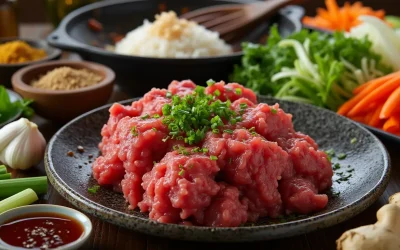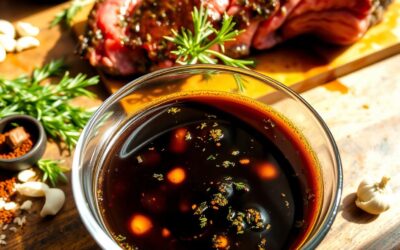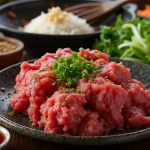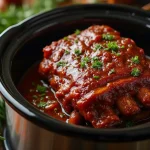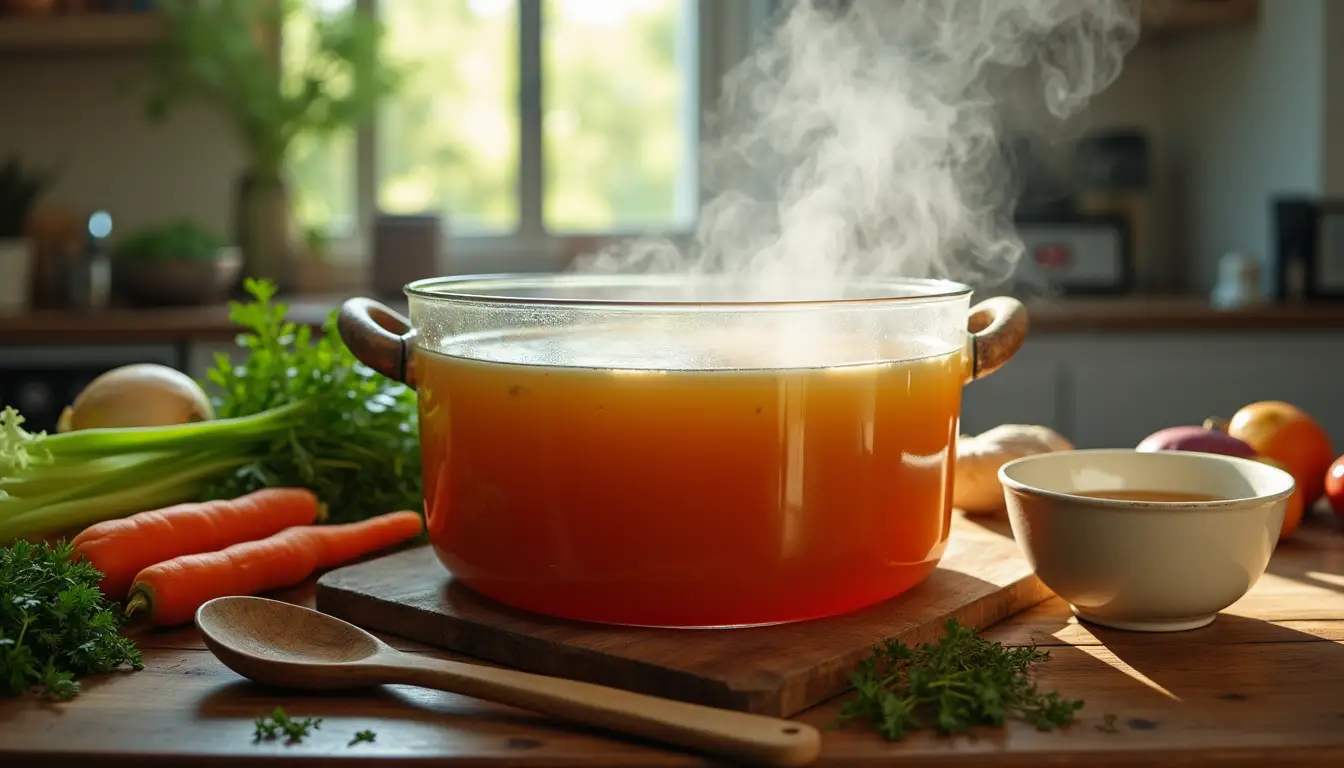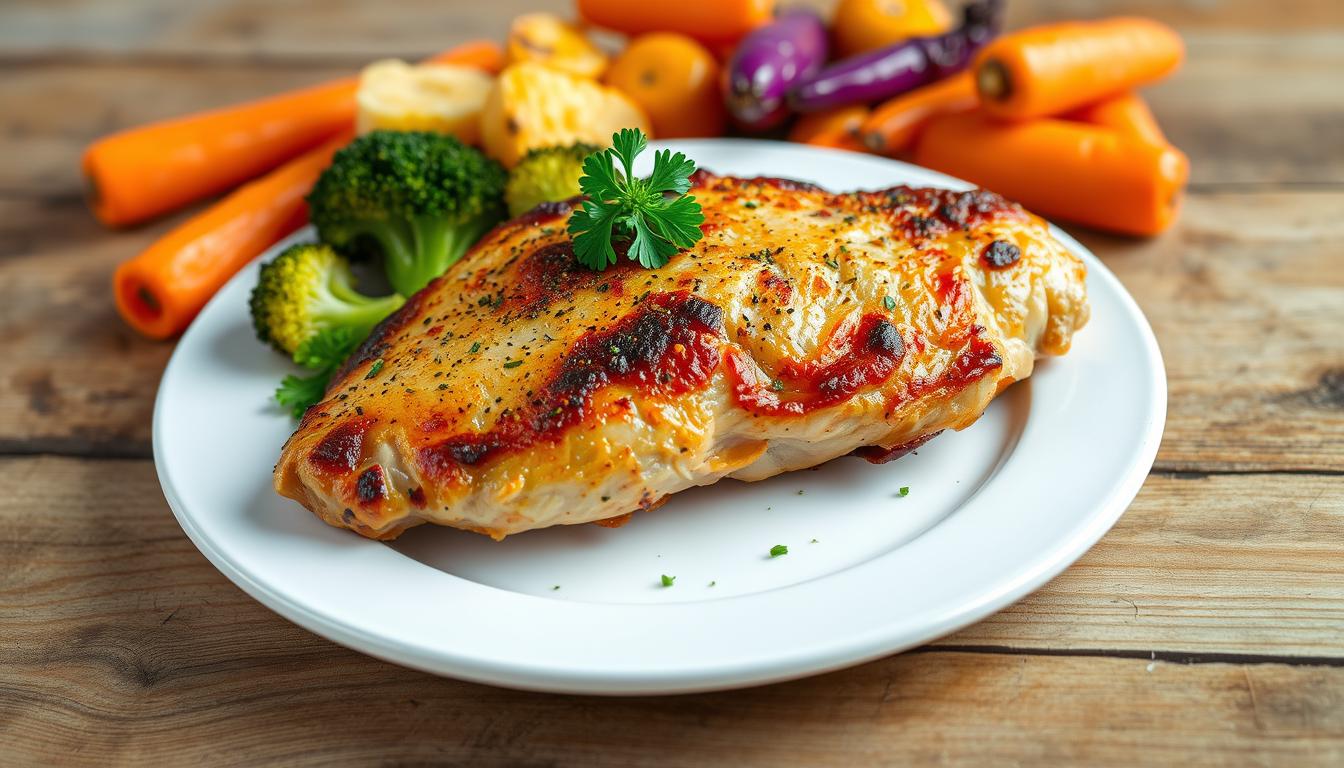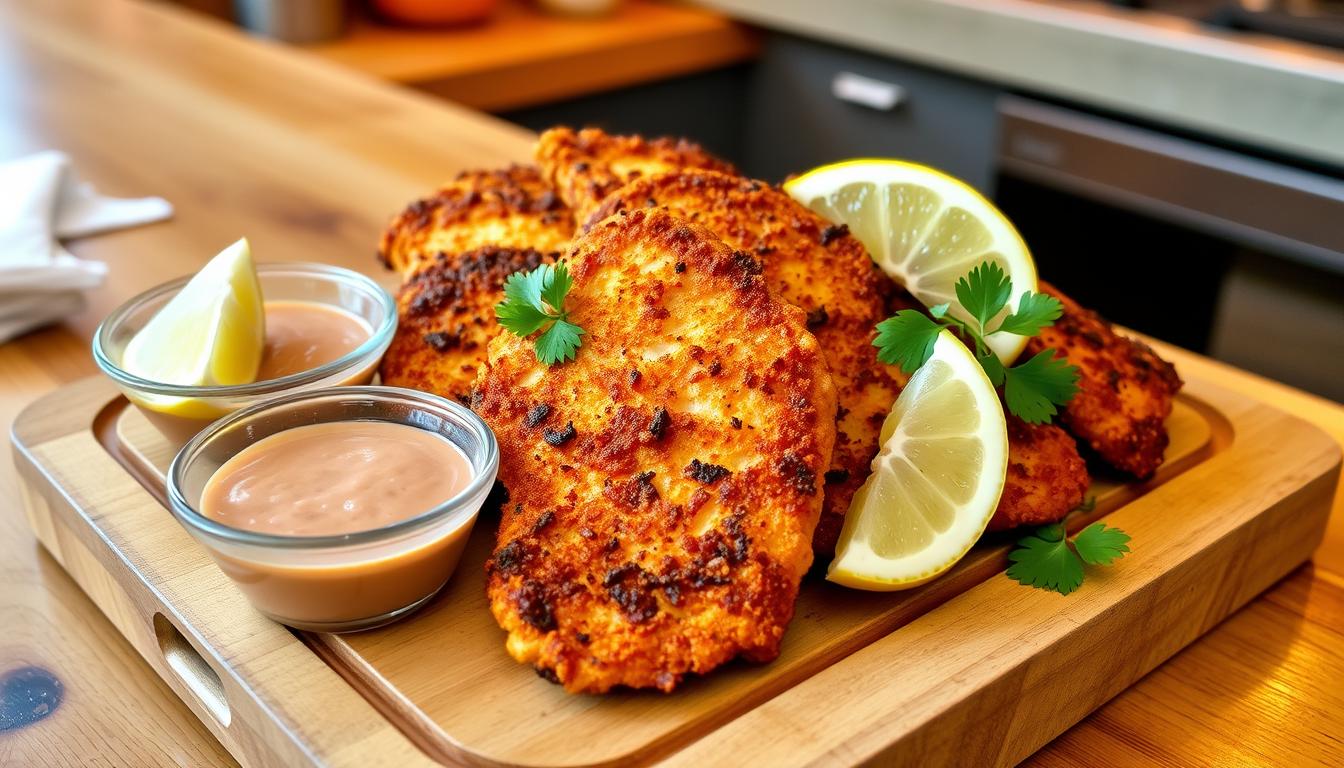I remember the first time I discovered chicken bone broth. It was more than just a recipe—it was a journey into nourishing food. It changed how I think about cooking and wellness.
Making chicken bone broth at home is an art. It connects us to cooking traditions passed down through generations. Whether you’re experienced or new to cooking, making your own broth can bring amazing flavors and health benefits.
This guide will teach you how to make perfect homemade bone broth. We’ll cover everything from choosing the right bones to cooking techniques that boost nutrition and taste.
Table of Contents
Understanding the Benefits of Homemade Chicken Bone Broth
Chicken bone broth is a nutritional powerhouse. It offers many health benefits that store-bought options can’t match. This ancient food has become very popular for good reasons.
Nutritional Value and Health Benefits
Your homemade bone broth is full of essential nutrients. A single cup has:
- 50 calories
- 9 grams of protein
- 280 mg of potassium
- 450 mg of sodium
- Critical electrolytes like calcium and magnesium
Why Homemade is Better Than Store-Bought
Making your own bone broth lets you choose the best ingredients. Commercial broths often don’t have the same rich nutritional profile as homemade ones.
Quality bone broth requires patient simmering for 6-24 hours to extract maximum nutrients and develop a gel-like texture.
Role in Gut Health and Healing
Bone broth is great for gut health. The gelatine in homemade broth helps with digestion. It can also help with inflammatory conditions.
| Nutrient | Health Benefit |
|---|---|
| Collagen | Supports joint health and skin elasticity |
| Glycine | Improves sleep quality and regulates body temperature |
| Amino Acids | Potential therapeutic effects for inflammatory bowel disease |
By making homemade bone broth, you’re not just cooking a meal. You’re creating a nutrient-rich drink that boosts your health.
Essential Ingredients for Perfect Chicken Bone Broth
Making a delicious chicken bone broth starts with picking the right ingredients. Your homemade broth can be full of flavor and nutrients. This happens when you choose each part carefully.
Types of Chicken Bones to Use
The key to a great bone broth is the quality of chicken bones. Choose a mix of bones for the best taste and nutrition:
- Chicken feet (high in collagen)
- Necks and wings
- Backs and carcasses
- Leftover roasted chicken bones
“Not all chicken bones are created equal – choose wisely for the best results.”
Vegetables and Aromatics for Bone Broth
Vegetables add depth and important nutrients to your broth. The classic mix includes:
- 2 large carrots (chopped)
- 2 celery stalks
- 1 large onion
- 3-4 garlic cloves
Additional Flavor Enhancers
Boost your chicken bone broth with these ingredients:
- 2 bay leaves
- Fresh herbs: thyme, rosemary
- Whole peppercorns
- 2 tablespoons apple cider vinegar
Pro tip: Roasting your chicken bones at 400°F for 20 minutes before simmering makes a big difference. This simple step can turn your bone broth from good to amazing.
Preparing Your Bones for Bone Broth
Roasting chicken bones is key to making a rich, flavorful bone broth. The right preparation can transform ordinary bones into a nutrient-packed culinary treasure. This step unlocks deeper flavors and boosts the quality of your homemade stock.
- Select high-quality bones from organic, grass-fed chickens
- Preheat your oven to 400°F
- Line a rimmed baking sheet with parchment paper
- Spread bones in a single layer
- Roast for 20-25 minutes until golden brown
“Roasting bones is the secret to a deeply flavored, restaurant-quality bone broth” – Professional Chef’s Tip
Different chicken bones offer unique benefits for your broth. Here’s a quick guide to bone selection:
| Bone Type | Flavor Profile | Nutrient Concentration |
|---|---|---|
| Chicken Feet | Rich, Gelatinous | High in Collagen |
| Neck Bones | Mild, Versatile | Good Protein Content |
| Chicken Carcass | Deep, Robust | Balanced Nutrients |
Pro tip: If you’re using bones from a previously cooked chicken, you can skip the roasting step. The bones will already have developed flavor during the initial cooking process. Collect and freeze bones from roasted chickens to build your broth-making stash.
Remember, roast chicken bones carefully to maximize flavor without burning. The golden-brown color signals perfect roasting – this caramelization is key to creating a depth of taste that will make your homemade bone broth truly exceptional.
Three Methods to Make Chicken Bone Broth
Making chicken bone broth at home is a fun adventure. You can pick the method that fits your schedule and kitchen best.
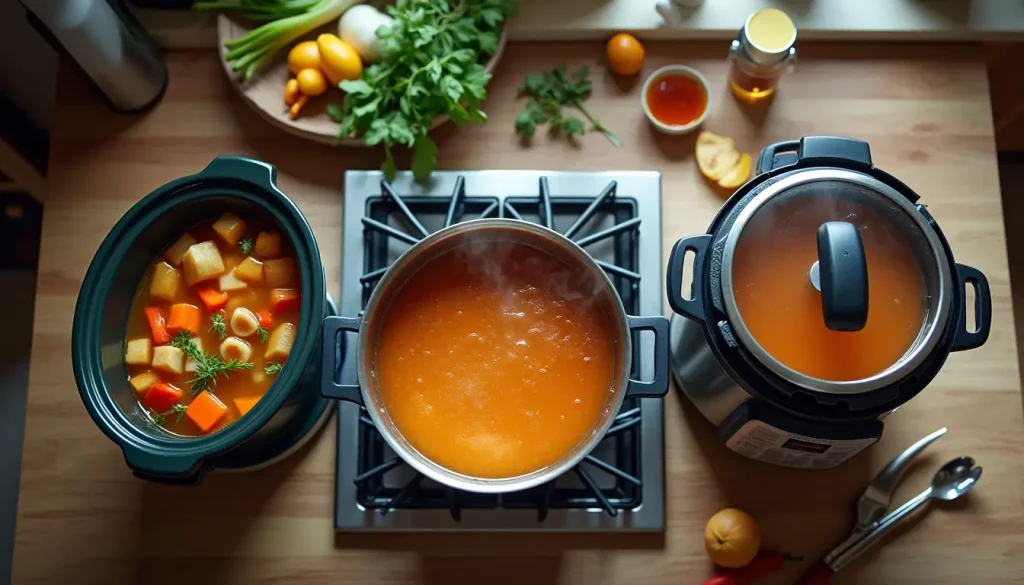
Let’s look at three popular ways to make bone broth. These methods will boost your cooking and nutrition:
Stovetop Bone Broth Method
The stovetop method needs patience and focus. You’ll need:
- 1-3 chicken carcasses
- Cold water
- Apple cider vinegar
- Vegetables for flavor
This traditional method takes about 15 hours. It extracts nutrients well. Simmer at 200 degrees for the best flavor and nutrition.
Slow Cooker Bone Broth Method
The slow cooker method is great for those who want to do less work. It’s easy and consistent. The benefits are:
- Overnight cooking capability
- Minimal monitoring required
- Even heat distribution
Your Instant Pot or slow cooker can make a rich, gelatinous broth easily.
Instant Pot Bone Broth Method
The Instant Pot is perfect for those in a hurry. It makes a strong broth in just two hours:
| Ingredient | Quantity |
|---|---|
| Chicken Parts | 4-8 pounds |
| Cooking Time | 2 hours |
| Yield | Approximately 10 cups |
“The right method can transform simple ingredients into liquid gold.” – Bone Broth Expert
Each method has its own benefits. Try them out to find your favorite way to make delicious, nutrient-dense chicken bone broth.
Step-by-Step Guide to Perfect Chicken Bone Broth
Making the perfect chicken bone broth needs focus and patience. It’s not hard, but it does require careful steps and technique.
“The secret to a rich bone broth is in the slow, careful extraction of nutrients from chicken bones.” – Culinary Experts
Here’s a detailed guide to help you become a pro at making chicken bone broth:
- Collect and Prepare Bones
- Use a mix of chicken parts: backs, wings, and feet
- Aim for 4-8 pounds of bones for maximum richness
- Roast raw bones at 425°F for 30-45 minutes to enhance flavor
- Create Your Broth Base
- Place roasted bones in your cooking vessel
- Add aromatic vegetables like onions, carrots, and celery
- Include 1-2 tablespoons of apple cider vinegar
- Cover completely with cold water
- Cooking Methods
- Stovetop: Simmer 24-36 hours
- Slow Cooker: Cook overnight (12-18 hours)
- Instant Pot: Pressure cook for 2-3 hours
Your goal is to make a gelatinous, nutrient-dense broth that’s full of health benefits.
| Cooking Method | Cooking Time | Nutrient Extraction |
|---|---|---|
| Stovetop | 24-36 hours | Maximum nutrient release |
| Slow Cooker | 12-18 hours | Good nutrient extraction |
| Instant Pot | 2-3 hours | Faster, moderate extraction |
Strain your broth through a fine-mesh strainer, cool it quickly, and store it right. For the best taste, refrigerate and use within 7 days or freeze for up to 6 months.
Tips for Achieving a Rich, Gelatinous Broth
Making a rich bone broth needs care and focus. You want a broth that’s full of nutrients and taste. The trick is knowing the small steps to turn bones into a healthy dish.
Temperature Control Techniques
Getting the temperature right is key for a great bone broth. Use a low simmer to get all the nutrients. This method keeps proteins intact.
- Keep heat low to prevent rapid boiling
- Aim for small, consistent bubbles
- Watch for temperatures between 185-205°F
Skimming and Straining Methods
Skimming is important for a clear broth. Use a fine-mesh skimmer to take out any bad stuff that floats up.
- Remove foam during first hour of cooking
- Use a clean, fine-mesh strainer
- Line strainer with cheesecloth for extra clarity
Testing for Doneness
A good bone broth shows itself in a few ways. Check the bones and how thick the broth gets when it cools.
| Doneness Indicator | What to Look For |
|---|---|
| Bone Texture | Bones should crumble when pressed |
| Broth Consistency | Becomes gelatinous when cooled |
| Cooking Time | 12-18 hours for maximum nutrient extraction |
“The magic of bone broth lies not in complexity, but in patience and technique.” – Culinary Nutrition Expert
Your bone broth is a journey of change. It turns simple things into a healthy drink that feeds your body and soul.
Storing and Preserving Your Bone Broth
Learning how to store bone broth right lets you enjoy it for weeks or months. It keeps the broth’s taste, nutrients, and quality just right.
Storage Container Options
- Ice cube trays for small portioned servings
- Freezer storage bags for flat, space-efficient storage
- Straight-sided glass mason jars
- Plastic freezer-safe containers
When you store bone broth, cooling it down is key. Always let it cool to room temperature before storing. This prevents damage and keeps it safe to eat.
Freezing Techniques
Freezing is the top way to keep bone broth. Pro tip: Leave about an inch of space in containers to allow for liquid expansion. Most homemade bone broth can stay frozen for up to 3 months.
| Storage Method | Duration | Best For |
|---|---|---|
| Refrigeration | 3-5 days | Short-term storage |
| Freezer Storage | Up to 3 months | Long-term preservation |
| Pressure Canning | 1 year | Shelf-stable option |
“Proper storage transforms your homemade bone broth from a simple cooking project into a convenient, nutritious pantry staple.” – Culinary Nutrition Expert
Always use clean, sanitized containers and label them with the date you made them. This keeps track of freshness and helps avoid waste.
Common Mistakes to Avoid When Making Bone Broth
Making the perfect bone broth needs careful attention and knowledge of common errors. Many home cooks face challenges that can lower the quality and health benefits of their broth.
Temperature Challenges in Bone Broth Preparation
Keeping the right cooking temperature is key. Aim for a simmer between 195 to 211 degrees F. Boiling too hard can lead to:
- Cloudy broth
- Mushy ingredients
- Less flavorful broth
Ingredient Proportion Problems
Getting the right mix of ingredients is vital for a tasty broth. Watch out for:
- Too many ingredients in your pot
- Cruciferous veggies that can dominate flavors
- Too much salt, which gets stronger as liquid evaporates
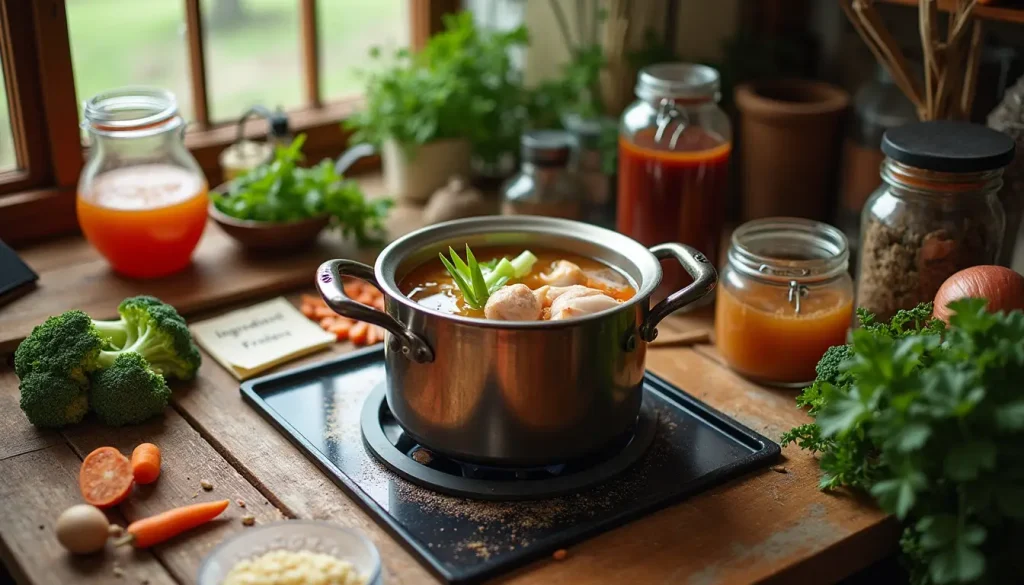
Storage and Preservation Errors
Storing your broth correctly is essential to keep its quality. Here are common mistakes to avoid:
- Freezing without leaving space for expansion
- Not cooling the broth before refrigerating
- Storing it for too long
| Bone Broth Storage Guidelines | Recommended Duration |
|---|---|
| Refrigerator Storage | Up to 1 week |
| Freezer Storage | Up to 3 months |
“Patience and precision transform good bone broth into an exceptional culinary experience.”
By knowing these tips and avoiding common mistakes, you’ll make a broth that’s full of nutrients. It will support healthy joints, digestion, and overall well-being.
Creative Ways to Use Your Chicken Bone Broth
Discover the amazing versatility of your homemade chicken bone broth! It’s more than just a soup base. It offers countless uses that can change how you cook.
Here are some ways to use your bone broth recipes in everyday cooking:
- Drink it straight from a warm mug with a pinch of sea salt and fresh herbs
- Replace water when cooking rice, quinoa, or pasta for enhanced flavor
- Create nutrient-rich smoothie bases
- Use as a liquid for poaching eggs or vegetables
- Blend into sauces and gravies for depth of taste
Bone broth is also great for cold dishes. Try these refreshing ideas:
- Freeze into ice cubes for smoothies
- Make bone broth popsicles as a healthy summer treat
- Craft chilled summer soups
- Use as a base for nutritious smoothie bowls
“Bone broth is nature’s highest source of dietary collagen, giving you amazing health benefits with every sip.”
Looking for unique bone broth recipes? Here are some gourmet options:
| Dish Type | Bone Broth Application |
|---|---|
| Cocktails/Mocktails | Add bone broth ice cubes for nutritional boost |
| Power Bowls | Cook grains in bone broth for extra flavor |
| Summer Salads | Create bone broth-based dressings |
Pro tip: Try adding dried seasonings like paprika or ginger to change your bone broth’s taste. The possibilities are endless!
Conclusion
Making homemade chicken bone broth is more than just cooking. It’s a game-changer for your health. It’s packed with minerals like calcium, potassium, and magnesium. These support your body’s health and bone strength.
Studies show that chicken bone broth is very nutritious. It has lots of collagen, which is good for your skin, joints, and gut. The amino acids in it help your body heal faster. This makes homemade bone broth a great addition to your diet.
Adding bone broth to your meals is easy. You can use stovetop, slow cooker, or Instant Pot. It boosts your immune system, reduces inflammation, and is tasty in many dishes. Starting your nutrition journey is simple with this ancient cooking method.
Choosing homemade chicken bone broth means more than just eating. It’s a step towards a healthier life, connecting you to ancient wisdom. Your body will be grateful for this nourishing drink that combines old traditions with new science.


